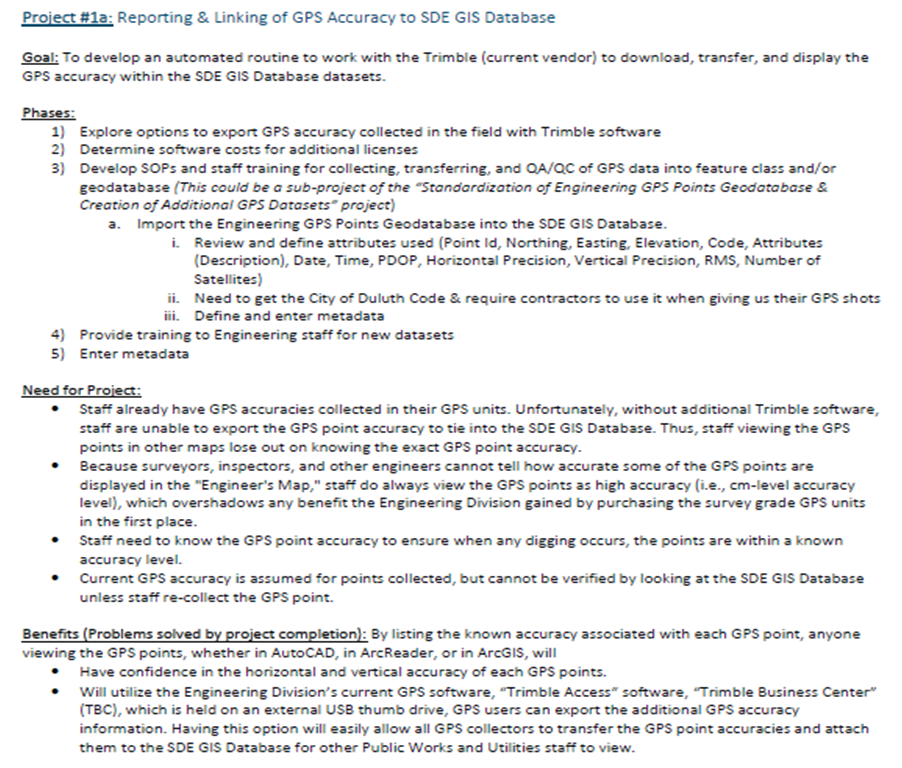Having Fun with a Homegrown Approach to a GIS User Needs Assessment
With a Bonus Implementation Plan!
Presented at the Northern Area GIS User Group Meeting, November, 19th, 2015

Kim Sundeen
GIS Specialist, City of Duluth, MN
work: 218-730-5082
work: ksundeen [at] duluthmn.gov
personal: kim.h.sundeen [at] gmail.com
@KSundeen
-
Scope Your Assessment Goals
-
Select Your Interview Panel
-
Plan Your Questions & Interviews
-
Translate & Digest Interviews into Results
-
Identify & Describe Project Overviews
-
Prioritize & Simplify Project Overviews
-
BONUS! Creating Project Implementation Plans
**I share the full report & results are shared on last slide.
Scope Your Assessment Goals
- Research other GIS User Assessments
- Decide what you want to learn from GIS users/managers
- To create new GIS tools?
- Offer more training?
- Find out how they use GIS?
- Get new ideas for GIS apps?
- Prep your staff with overview of:
- When interviews will be
- Why interviews are important
- Expected outcomes of interviews
- What will be discussed during interviews
EXAMPLE:
Scope Your Assessment Goals
- Research: Google search, contacted City of WI Rapids, Used Esri's "Building a GIS"
- My Goals: to find out how GIS is used to develop more efficient & simplified GIS tools that streamline engineering staff job activities

Select Your Interview Panel
- Identify all GIS users, editors, & managers
- Split them into interview panel "groups" by job junction
- Consider each function as performing specific GIS tasks
- Splitting by job function simplifies questions
EXAMPLE:
Select Your Interview Panel

Plan Your Questions
- Questions emerge from job functions
- Create question template ...stimulates conversations during interviews
- Chose range of questions:
- Multiple Choice (easy to quantify in results)
- Open-ended (for good discussion)
- Offer check-lists of data types, maps, apps...etc.



EXAMPLE:
Plan Your Questions
Recall...
- Overall Goal: to understand how GIS is used in PWU ("GIS Worflows)" & provide training, new data & apps to improve data access
- Interview Panel: only PWU staff

Plan Your Interviews
- Send initial, introductory email to interview panels
- Start talking, sending emails, & scheduling interview meetings
- Meeting length:
- Expect initial meetings: ~1-2 hours
- Follow-up meetings: ~30 min
Translate Interivews
- Keep paper records of interviews
- Transcribe answer into spreadsheet program for summarizing & formatting
- Summarize GIS Business Workflows (how GIS is used)
- Useful for outlining SOPs later
EXAMPLE:
Translate Interivews
- Used MS Excel to sort, filter, search, & summarize across interview panel groups
- Each header field = basic interview question
- Header fields used:
- Group by Responsibility
- Staff Involved
- Perceived GIS Benefit
- GIS Function/Operational Responsibility
- General Overview for How & Why Group Uses GIS
- Current Geographic Activity (= GIS Workflow)
- Databases Used
- Obstacles Faced in Using GIS
- Suggested GIS Apps & Ideas
- Estimated # Staff to Benefit by new App/Idea
- Potential Project to Overcome Obstacle
Digest Interviews into Results
- Outline how you want to present your results
- Outline I used:
- Summarize all categorical results into tables
- Semi-summarize descriptive questions by each interview panel group
- Similar to research paper "Discussion"
- Summarize the group's summaries to highlight Overall Common Themes
EXAMPLE:
Digest Interviews into Results
- Summarize categorical results into tables
- Semi-summarize descriptive questions by each group
- Use their answers..."What major obstacle do you face while working with GIS?"
- Common themes by each group
- Perceived GIS benefit; How GIS is used; Major obstacles


-
Highlight Overall Common Themes
- Limited time
- Complex/inconsistent GIS wokflows
- Lack of GIS standards
- Lack of knowledge in map use
Identify & Describe Project Overviews
- Consider solutions to Common Obstacle Themes
- Data access issues
- Lack of GIS standards
- Training needs...etc
-
Chances are...you already know which projects are needed!
- Now, you have the background & justification for why those project are critical!
Identify & Describe Project Overviews (cont.)
- Project Overview = simple description for decision-makers & to facilitate project prioritizing
- Provide overview for each project:
- Goal of Project (or scope)
- Phases (or objectives)
- Project Need (or problem addressed)
- Budget & Resources Required
- Who's Involved (staff, stakeholders, team members, other orgs...etc)
EXAMPLE:
Identify & Describe Project Overviews

Prioritize Project Overviews
- Simplify - Simplify - Simplify
- No one wants to read entire project description to know how important it is
- Dumb each project down from Project Overview into simple list for decision-makers to prioritize
EXAMPLE:
Prioritize Project Overviews

BONUS: Creating Project Implementation Plans
-
Implementation Plan =
- A proactive management tool to detail a project's critical steps from start --> finish
-
Why is it Important?
- Avoids "putting out fires" (crisis-management) by instead engaging stakeholders at start to consider all steps involved
- Saves times, energy, & money in the end
-
How will it be Used?
- All parties involved have common doc to refer to goals, timeline, expected outcomes...etc
- All parties will be on same page
EXAMPLE:
Creating Project Implementation Plans
- Define phases & specific tasks in each phase
- Establish timelines with Milestones
- Determine how project completion will be evaluated
- Identify lead project manager, team members, & stakeholders
- Assign responsibilities & tasks to individuals
- Establish communication expectation with team members & stakeholders
Implementation Plan Sources:
http://www.brighthubpm.com/project-planning/87423-putting-together-a-project-implementation-plan/;
EXAMPLE:
Creating Project Implementation Plans (cont.)
2. Establish timelines with Milestones

What Are Your Next Steps?
Kim Sundeen
GIS Specialist, City of Duluth, MN
work: 218-730-5082
work: ksundeen [at] duluthmn.gov
personal: kim.h.sundeen [at] gmail.com
@KSundeen
